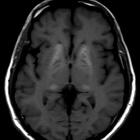eye of tiger sign

Eye of the
tiger sign (globus pallidus) • Tiger eye (photo) - Ganzer Fall bei Radiopaedia

Eye of the
tiger sign (globus pallidus) • Pantothenate kinase-associated neurodegeneration - Ganzer Fall bei Radiopaedia

Neurodegeneration
with brain iron accumulation • Pantothenate kinase-associated neurodegeneration - eye of the tiger sign - Ganzer Fall bei Radiopaedia

Eye of the
tiger sign (globus pallidus) • Pantothenate kinase-associated neurodegeneration - eye of the tiger sign - Ganzer Fall bei Radiopaedia

Eye of the
tiger sign (globus pallidus) • Pantothenate kinase-associated neurodegeneration - eye of the tiger sign - Ganzer Fall bei Radiopaedia
The eye of the tiger sign refers to abnormal low T2 signal on MRI (due to abnormal accumulation of iron) in the globus pallidus with a longitudinal stripe of high signal (due to gliosis and spongiosis).
The eye of the tiger sign is most classically associated with pantothenate kinase-associated neurodegeneration although it is not pathognomonic . There are no formalized criteria for the sign and other conditions may demonstrate a similar appearance, such as Wilson disease , atypical parkinsonism and organophosphate poisoning ; it may also be a normal finding on a 3 T magnet . Therefore, caution should be used when interpreting this sign.
Siehe auch:
- Basalganglienverkalkungen
- Globus pallidus
- T2 hyperintense Basalganglien
- basal ganglia T1 hyperintensity
- Neurodegeneration mit Eisenablagerung im Gehirn
- Kortikobasale Degeneration
- decreased T2 signal in the basal ganglia
und weiter:

 Assoziationen und Differentialdiagnosen zu eye of tiger sign:
Assoziationen und Differentialdiagnosen zu eye of tiger sign:




